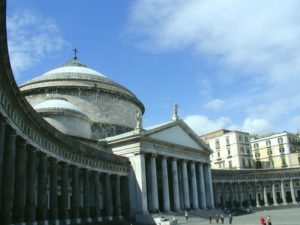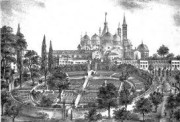Brief City’s History
The first traces known about the City of Naples date back to the last of the three Stone ages, the Neolithic. At those times, Naples was Parthenope, a Greek City between the Phlegrean fields and the volcano Vesuvius. Parthenope, founded by the greek settlers called Cumanians, means virginal and was choosen to identify one of the mermaids once worshipped in the Great Greece. Once the aristocracy chased away the tyrant Aristodemo da Cuma, it founded Neapolis, which means New City. In 326 BC Naples was conquered by Romans, even if its traditions and language remained Greek until 200 AD. The City was considered beautiful and relaxing and that’s why some Emperors, among whom Nero and Claudio, chose it as their favourite relaxing place. At the end of the Roman Empire, Naples hosted the last Emperor Romolo Augusto who was deposed by Odoacre, the king of Heruli ( an East Germanic tribe ) in 476 AD ( the date which officially ratified the end of the western Roman Empire and the beginning of the Middle Ages ) and spent his old age here, in Egg Castle, the former huge villa of Lucullus. In 536 AD the Byzantine Empire ( the eastern Roman Empire ) conquered it in the Gothic War and made it a Duchy. Subsequently a long period of wars followed, against the Lombards and the the Saracens ( Muslim pirates ). A long period of peace brought wealth and culture to the City. It all lasted until the conquer, in 1139 AD, made by the Normans that brought it inside the Kingdom of Sicily. During this period the prestigious University of Naples was founded by Federico II° ( 1224 AD ). In 1226 AD the last Swabian King Manfredi of Sweden lost a battle for the Reign of Sicily, and therefore for the City too, against Charles I° of Naples ( the Capetian House of Anjou ), a French noble who kept the government ( managing to attract there many famous artist of that time ), for him and his descendants, until 1442 AD, when Naples, as many other territories in the southern Italy, was taken over by the Crown of Aragon, a powerful Spanish Lordship. During the Spanish period the population increased considerably making it one of the most populous western Cities and also the construction of many important buildings changed much its face. The French tried to regain the control of the City with Charles VIII°, but their efforts were vain because after a very brief domination ( 1501 – 1504 AD ), the Spanish took over it once again and this time their domain was destined to continue. After eight wars, lasted more than sixty years, between France and Spain, which saw the second one triumph over the first one, between 1647 and 1657 AD, Naples had to face many ordeals, ranging from some internal uprisings born from French and Neapolitan nobles, till the Vesuvius’ eruption and the plague, which made a real carnage. In the early 1700s the War of the Spanish Succession caused the momentary loss of Naples ( 1707 AD ) in favour of Austria, which kept the City only for 27 years, until the Spaniard Charles of Borbone conquered it again, creating an indipendent State which included all the southern Italy and Sicily and of which Naples became the great capital, renowned in the whole Europe. In 1799 AD some uprisings began and Naples became, only for some months, a free Republic; soon, however, it was returned to Bourbons, to be lost by them one more time, in favour of Napoleon troups. With Napoleon’s defeat in 1815, and the subsequent Congress of Vienna, the City was given back to Bourbons. It has been on February 14th 1861 AD the final chapter of the Spanih domination over Naples, with the depart of the Spaniard King Francesco II di Borbone and his wife the Queen Maria Sofia, by sea, toward Rome, exiled there, as guests of the Pontiff. Meanwhile Naples was annexed to the newborn Reign of Italy, losing its status of capital and many of its industries; this fact triggered a long, deep crisis, that has provoked many economic and social problems to a City that was, before then, a cradle of culture and affluence.
The City
Naples is an Italian town of about 975,260 inhabitants, capital of the metropolitan City and of the Campania region. It is the third most populous in Italy and one of the most populous urban areas and densely populated of European Union. The historic center of Naples is the largest in Europe and in 1995 AD has been recognized by UNESCO as a World heritage site. Naples, Napulè for the Neapolitans, it’s a big City, one of a kind, overlooking a beautiful bay and full of contradictions. Here you will find very beautiful and luxurious neighborhoods as Posillipo, Vomero, Chiaia, Mergellina and Saint Lucia, side by side with the more complex and much less secure neighborhoods, especially after dark, as the Spanish Quarter, Health Market, Fork and the suburban districts. The Spaccanapoli neighborhood is also very typical, but the same here it’s important to pay a bit attention. Naples is like that: chaotic and charming; there are both crime and culture, both great poverty and great wealth. In Naples you will find: the Pontaniana Academy, founded in 1400 AD by men of culture for cultivating the arts, sciences and letters; the Federico II°, the oldest state university in Europe; the Orientale, the oldest university of Sinology and Ancient Oriental Studies in Europe; the Neapolitan music school, founded in 1500 AD, benchmark of classical music and opera and renowned for having created the comic opera (an operatic genre) and the Nunziatella, one of the oldest military academies of the world. Naples is also famous for: its landscape painters of 1600 AD, the traditional Neapolitan song, the ‘Baroque architecture, the historical tradition of crib and ceramics (Capodimonte ceramics), the funny masks of its art comedy (Pulcinella the comic actor , Tartaglia the doctor and Scaramuccia the captain). Naples is in fact a crazy blend of beauty, melancholy, culture, decay and history. The text of the famous song “Napule è”, written by a great neapolitan singer-songwriter, the one who maybe better described this City, reads more or less like this: Naples is a thousand colors, Naples is a thousand fears, Naples is the voice of children that rises slowly and you know you are not alone, Naples is a bitter sun, Naples is the smell of the sea, Naples is a dirty paper and no one cares, and everyone expect their luck, Naples is a stroll around the alleys among the people, Naples is all a dream and he is known all over the world, but they do not know the truth. Finally when it comes to Naples you can not fail to mention the dish that made her famous all over the world: the Neapolitan pizza, born here around 1700 AD and recognized globally as the unique and original pizza.
Here are the main Monuments to visit in Naples:
1. Castel dell ‘Ovo: it’s the oldest Castle of Naples; located in front of the typical port of St. Lucia, on a small island, called, since ancient times, “Megaris”. In the ancient times it was the villa of the Roman general Lucius Licinius Lucullus; subsequently, in the the twelfth century, some pre-Normans fortifications arose over its ruins. These fortifications were first transformed into a real Castle by Frederick II° before and further expanded by the Angevins after, renaming it “Castel dell ‘Ovo”. In the Caastel were imprisoned some famous people as Conrad of Swabia, Beatrice of Sicily and Tommaso Campanella, and others.
2. Plebiscito Square: The huge square has a semi-circular shape and has been designed by the architect Leopoldo Laperuta during the ten-year Napoleonic occupation, with the aim to become a parade ground for military parades. After the end of the occupation the City and the return from Sicily to Ferdinand IV° of Bourbon, the majestic circular Church of San Francesco di Paola was erected, which, along with the Royal Palace, overlooks the large theatrical square.
3. San Carlo Theater: it is the oldest Opera House in Europe still active. The Theater was designed by he architect Antonio Medrano and built by Angelo Carasale in 1737 AD. Its Inauguration was held on November 4th, the name-day of King Charles of Bourbon, a strong backer of the building, as part of a project aimed to raise Naples to be a great European capital. Totally destroyed by a fire in 1816 AD it was fastly rebuilt in neoclassical style in only 9 months, by the architect Antonio Niccolini.
4. Principe di Napoli and Umberto I° Galleries:
. The Principe di Napoli Gallery is located in Via Broggia. It was born between 1870 and 1883 AD, with a gorgeous project of Nicola Breglia. Designed to be the commercial City centre, it was carefully finished with a majestic glass cover. Originally it was supposed to have 4 arms, but then only three have been realized for the vicinity to the Church of Santa Maria in Constantinople. Today it hosts mainly to state and private offices.
. The Umberto I° Gallery, located in Via San Carlo, is wider than the first and was also built as a commercial area, between 1887 and 1890, with a project of Luigi Emanuele Rocco, Ernesto Mauro and Antonio Curri. The impressive external façade, the glitz and the richness of its stucco decorations and the majestic iron and glass roof, make it a piece of architecture. Internally it is composed by two huge corridors delimited at their extremities by four buildings, with the cover and the dome with eight spandrels enriched by eight female figures holding the chandeliers.
5. The Royal Palace of Naples is surrounded by other great historic buildings. The Royal House of Bourbon of Naples used it, along with 3 other residences: the Royal Palace of Caserta, the Royal Palace of Portici and Capodimonte Royal Palace. Built in 600 AD, was home to the Spanish viceroy, the Austrian viceroy , the Bourbons House and later the Savoy. In 1922 AD it became Bibilioteca National. His beautiful long façade, 169 meters, is home to 8 statues representing the various King of Naples. The courtyards, the gardens and the many beautiful rooms make it a truly unique property.
6. The Duomo of Naples: The Cathedral of Naples, located along the homonymous street, incorporates, sidewise, two other religious buildings that arose independently of the cathedral: the Basilica of Santa Restituta, which incorporates the Baptistery of San Giovanni in Fonte, the oldest in the whole West, and the Royal Chapel treasure of San Gennaro, which houses the relics of the Patron Saint of the City. The Duomo was built in 1300 and modified several times over the centuries and after some earthquakes, the last neo-Gothic façade dates back to 1905 AD.
7 . The Mont Vesuvius stratovolcano: the Vesuvius is the only active volcano of this kind in Europe. It is about 10 kilometers from Naples and has a base diameter of about 20 km while its peak is at 1,281 meters above the sea level. It is a stratovolcano considered quite dangerous and is much visited for its ease of access. Vesuvius was once a fertile hill, covered with vineyards and orchards, until, in 79 AD, its biggest eruption destroyed, submerging of ashes and incandescent lapillus several meters high, the Cities of Pompeii, Herculaneum, Oplontis and Stabia. Subsequently, the volcano has had various eruptive cycles and it is now quite some time that is in the quiescent phase.
8. Spaccanapoli: The lower decuman, built in the Greek Era, along with the superior decuman and major decuman is one of three major roads crossing the ancient Naples. This road, called “Spaccanapoli”, during the Middle Ages, was filled with Monasteries and homes of prominent men. The road, which separates the North from the South of the ancient Naples, is actually a set of seven streets: Via Pasquale Scura, Via Maddaloni, Via Benedetto Croce, Via San Biagio, via dei Librai, Via Vicaria Vecchia, Via Forcella and Via Giudecca. Along the way you can admire Baroque palaces and Churches, souvenir shops and craft shops, antique shops and delicatessens.
9. Subterranean Naples: For the construction of the ancient fortifications of Naples it was used tufa, a readily available and workable stone. As tufa was being dug into the ground, a deep web of underground tunnels under the City was forming. This maze of tunnels and passages that extends, at 40 meters deep, was primarily exploited by the Romans to create a water reservoir that each house built on the surface was able to use through the wells, afterwards it became a way out of the Bourbons towards the sea, a dwelling during famines, and as a refuge during World war II.
10. The Campi Flegrei Area : The Campi Flegrei Area is a large zone with volcanic activity of very ancient origin (about 40,000 years ago); a huge caldera with a diameter of about 15 km located in the Gulf of Pozzuoli, north-west of the city of Naples and its bay. The area has some craters, volcanoes and lakes (Averno lake, Lucrino lake, Miseno lake and Fusaro lake). Some volcanoes have gaseous emissions (Solfatare), while others have thermal waters (Agnano, Pozzuoli, Lucrino). In 2003 the Regional Park of Campi Flegrei has been established. The area has many beautiful landscapes thanks to its volcanic origin.
11. Other important Places to visit: the Basilicas of San Paolo Maggiore, Santa Maria Donnaregina Vecchia, San Gregorio Armeno, Girolamini, Sant’Angelo a Nilo, Incoronata Madre del Buon Consiglio, Santa Maria la Nova and Santa Maria in Portico; then Villa Floridiana, the Nisida Island, Virgiliano Park, the Coral Museum and Sant’Elmo Castle.






